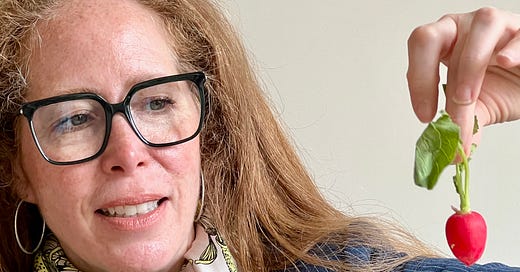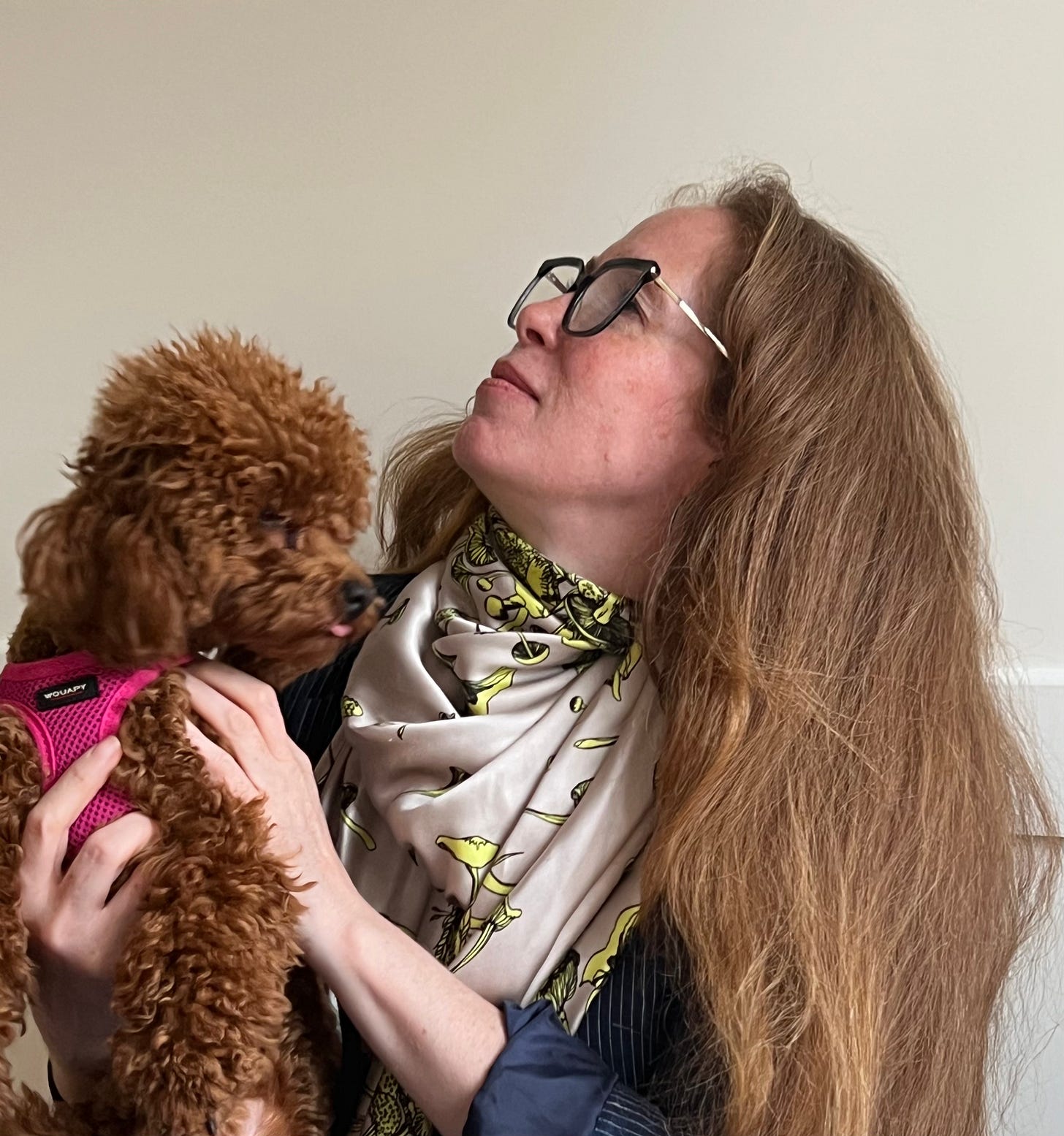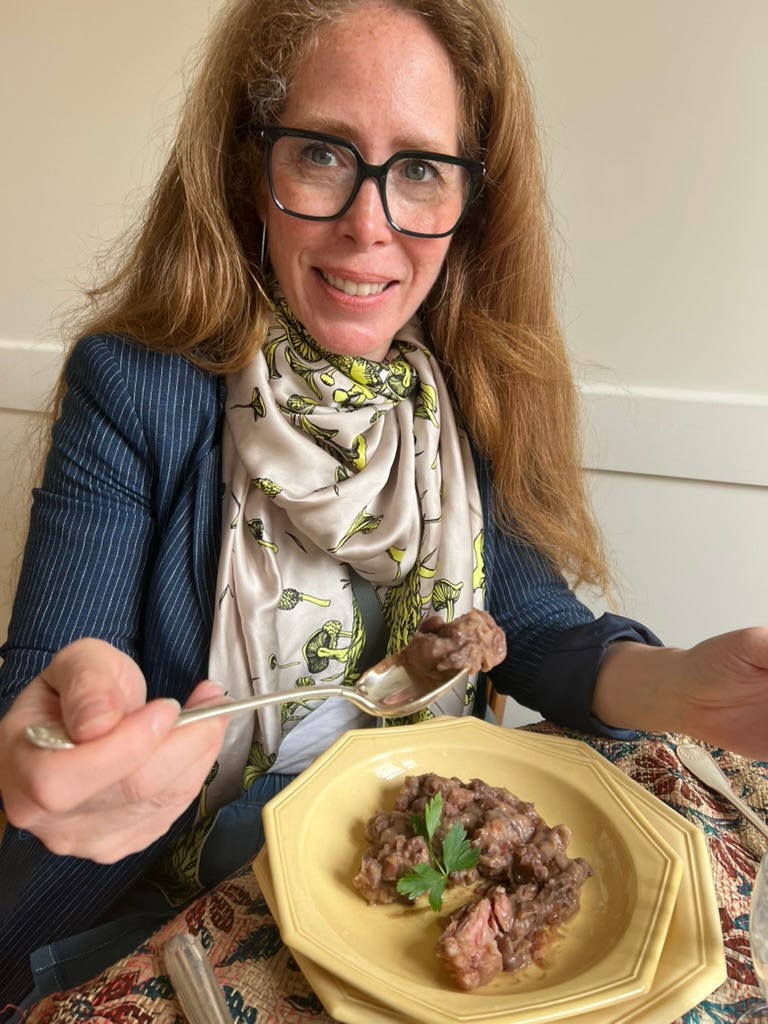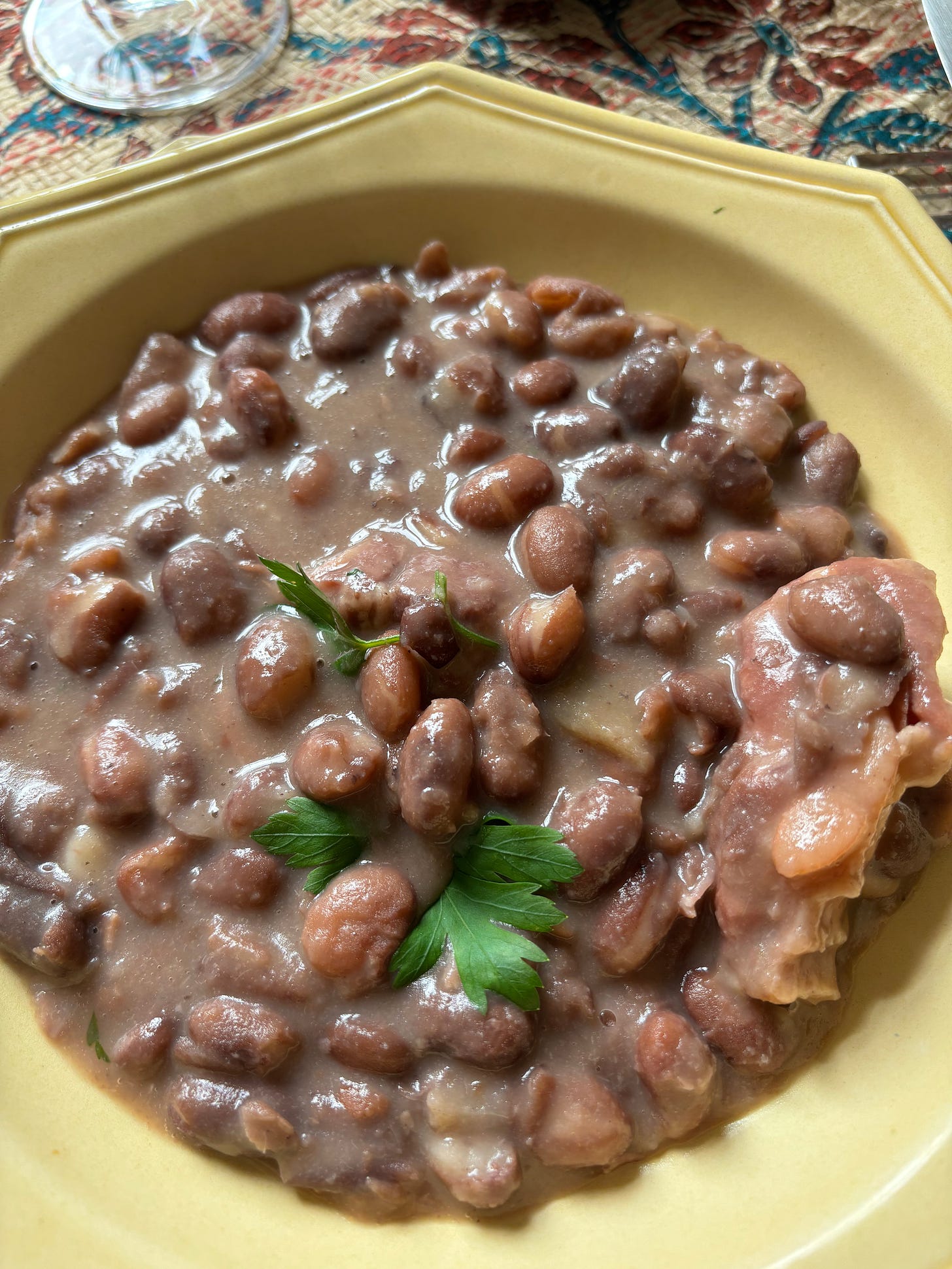With this portrait, I begin a series of interviews with people from around the world about their food memories.
Memories of dishes, aromas, flavors shape us all, and bring forth so many stories. They cross cultural divides, they are unique yet universal. As you will see in the following, themes of transmission and freedom, nostalgia and warmth are pervasive when it comes to food memories. I invite you to join me, and I welcome your comments and suggestions.
Jane Bertch walks up to the café surrounded by a burnished halo, her red hair. Polite to the extreme, she is careful with her greeting, a kiss on each cheek, then a graceful settling into a chair. We’re seated outside on a fine spring day, and both order an exprès.
Jane is one of the owners of La Cuisine Paris, the only cooking school in the city oriented specifically to English speakers (aside from the classes that I give), which offers classes on everything from croissant making to the intricacies of macarons. It’s the center of a certain culinary universe, and Jane makes sure it stays that way. She is endlessly curious, and keeps her pulse on what the world wants to learn while in Paris, making sure it’s on the school’s “menu”.
She is also the author of THE FRENCH INGREDIENT, a memoir that she hastens to say, “Is not a food book. I’m not a food person. In fact, I don’t love to cook. Well, I can cook, and I do cook, but cooking is not my passion.”.
So how did she come to be the owner and poster-woman for La Cuisine Paris? “Sadness and necessity played into it. I’d just lost a favorite uncle, then right after that my grandmother. It was 2008, I was in banking, and nothing was certain. I was at a New Year’s Eve party, friends and I were talking about what we might do next, and I said we should open a cooking school, but I could just as easily have said that I wanted to take up tap dancing,” she said.
Jane is one of the funniest people I know, with a wry outlook. She loves living in Paris, a “fancy city,” but claims to be unfancy and unsociable, hates to go out at night, rarely entertains and prefers to be alone or with her partner and her pets, Pantoufle and Caramel. Yet everyone wants to spend time with her, and if her name comes up, instantly afterwards there is the comment, “Oh, I love Jane!” because she is consummately charming and sociable, and knows exactly how to bring out the best in people.
“After that New Year’s party, I kept thinking about the idea of a cooking school. I jumped in without a clue as to what we were doing,” she said, a slightly artless statement because Jane is very good at business, and she knew the idea was something needed in Paris. “The thing is, it doesn’t matter that I own a cooking school and that my passion isn’t cooking. I love creating a shared experience around the table, because I hold preciously the idea that people with different views can come together over good food. At the table, everyone is equal.”
This comes from Jane’s childhood in a small, tight-knit family in Chicago, where meals were sacrosanct. “We were a modest, Midwest family. Food was family time; my grandmother did all the cooking, because feeding the family was the most important thing she could do,” she said. “We had the most basic dishes like cornbread and greens, stewed beans, peach cobbler.”
Jane was the only child in her family, and she basically grew up in her grandmother’s kitchen. “I was grandma’s kitchen witch and had to snap green beans or do other boring tasks instead of getting to do fun things like go out and play,” she remembers. “I loved my grandmother, but I hated helping out in the kitchen. But in the end, I guess being in a kitchen is my life’s work.”
Jane remembers her grandmother making every holiday special, with food. Thanksgiving was turkey with all the fixings, the Christmas meal was a three-day affair that included ham and turkey, sweet potatoes, mashed potatoes, green beans. Easter was always colored eggs, and Saint Patrick’s Day was corned beef. “You had to praise her throughout the meal. She would always say ‘This food didn’t just jump off the stove’ and that’s when the praise had to come on thicker and faster,” she said.
Now she is nostalgic about those hours in the kitchen with her grandmother. “I may have hated the slavery then, but I would give anything now to see her gnarled fingers grab the lilac coffee cup that she used to measure things. I still have that cup. And besides, I could safely try out things on her while I was working. I remember being pretty little and I was dying to use the word “shit,” which was outlawed by my mother. So, I’m cleaning greens and there is something on one of the leaves. I got up my courage and asked grandma if it was bird shit. She had her back to me and was silent, then turned around with a glare and told me I was naughty and that she would tell my mother. And then she did a sort of silent laugh. And never told.”
Jane runs La Cuisine efficiently in her office upstairs from the gleaming kitchens on the Quai de l’Hotel de Ville. She benefits from the delicious aromas wafting up the stairs and descends to check out what is going on and greet people. The chefs Jane employs to teach at La Cuisine Paris are top-shelf, and they instruct students in the art of making fresh, seasonal, and varied dishes that reflect the depth, flavor, and esthetics of French cuisine.
Jane may occasionally lead a market tour or one to a specific arrondissement, but she never spends time in the school kitchens. Her cooking is reserved for home.
“I cook every day,” she said. “But my food is the most simple you can imagine, and I feel like all I make is broccoli. We eat so much broccoli it should be outlawed. I roast it or sauté it, add some strips of chicken breast or salmon, and that’s it.”
If you ever go to a restaurant with Jane, you immediately discover her favorite dishes. She rarely varies, ordering a starter of oeufs mayonnaise,hard-cooked eggs slathered in a tangy mayonnaise, which is about as basic as you can get. She usually follows it up with rare steak and crisp frites. “If it’s winter, I love a slutty red wine; if it’s summer, I have rosé. Sorry, but that’s just the truth,” she says, as though she should say her favorites are brains in cream sauce, or wild birds stuffed with truffles.
Her favorite dish from childhood? “Pinto beans and pork,’ she said before the question was even fully out. “When I first moved away from home my grandmother would make it, freeze it, and my mother would Fedex it to me,” she said “My mother still makes it for me every time I go home to visit, for my first meal. I find it so sweet that she does this, and even though it isn’t as good as what grandma made, I love it.”
Does she ever prepare it? “No, of course not. I am incapable of making it.”
She claims she is incapable of following a recipe, too. “I cannot do it. And on the rare occasions when someone comes to dinner, if they love something I tell them to enjoy it, because I will never be able to make it the same way again.”
She does cave in to her kitchen witch status once a year, to prepare Thanksgiving dinner. “I make a huge meal with all the fixings, and I channel my grandmother at all times,” she says. “I do it all by feel and smell and have no idea until it is on the table whether or not anything will taste good.”
Too modest, her food is delicious. But you cannot tell her this, or she will turn red as a beetroot and deflect the compliment. “My food is simple, the food I love is simple,” she stresses. “In fact, I don’t love what the food world has become, because it is so elitist. Humans have this capacity to create hierarchy and that has happened in the food world. But food isn’t about that. It’s about transmission, being together, sharing.”
Jane has lived in Paris for twenty years after a stint in London. “One of my biggest take-aways from life here is how intentional the French are about who they invite to a meal,” she said. “Here, there can be huge arguments around the table, but people end up friends. And while the food is important, an evening around the table is so much greater than what you’ve cooked. It is so simple, the way it should be, and it takes off some of the pressure.”
The school keeps Jane very busy, yet she has had time in the last few years to write that first book, and get an Executive Master’s in coaching and consultancy (which follow her a BA in English and Women’s Studies, and an MA in Labor and Industrial Relations). She will stay at the school, yet she has dreams.
“I’m thinking about studying neuroscience and I want to do public speaking,” she said, then blushed fiercely. “I just have a small dream to transform the world. I don’t know for sure what is nex; there is definitely something bigger than us that truly is the guide.”
As we prepare to go our separate ways, Jane reaches down for her bag and pulls out a giant package of Reese’s peanut butter cups. “Oh my god I love these. One of the students brought them for me today,” she says, breaking into one of her huge, eye-glittering laughs. “These and crunchy Cheeto’s make me a happy person.” She wraps her scarf around her neck, loops her bag over her shoulder, and we embrace.
“I’m off to cook up some broccoli,” she says with another laugh ,and away she went.
JANE’S FAVORITE BEANS WHICH SHE NEVER MAKES
Jane said she trusted me to try and recreate her favorite beans and pork. I knew I was risking something big, but I remembered a recipe from FARMHOUSE COOKBOOK, so I referred to it and made them. She came over for a taste. We preambled through radishes, butter and bread, then the big moment arrived. She took a spoonful, closed her eyes, and chewed. “It’s so good,” she said, and her face had the wide-eyed look, as though she were channeling the little girl she once was. “No, I mean it, it is so good.” That was it, all she said, because she was busy cleaning her plate.
8 ounces (250g) salt pork, cut in 3 equal-sized pieces
1 pound (500g) pinto beans (or pink or navy beans)
½ teaspoon baking soda
1 large onion, diced
1 bay leaf
1 bird’s eye pepper
Salt and pepper to taste
1. Bring 2 cups water to a boil in a small saucepan. Add the salt pork, return to the boil, then remove from the heat and drain.
2. Place the beans in a large pot, cover with water, add the soda and bring the water to a boil. Remove from the heat and let sit for one hour, then drain and rinse thoroughly. Return the beans to the rinsed pan, add the salt pork, the onion, the bay leaf, and the bird’s eye pepper and cover by 2-inches (5cm) with water. Bring the water to a boil over medium-high heat, reduce the heat to medium low so the water is simmering and cook, partially covered, until the beans are tender but not mushy, about 40 minutes. Season to taste with salt and pepper, then keep hot over medium heat. If the beans look dry in the least, add enough boiling water so there is some liquid, but not too much so they are water.
3. To serve, ladle the beans into shallow soup bowls and, unlike Jane’s grandmother, garnish them with a sprig of parsley.
Serves 6 to 8








Susan, you have so many talents but the one I love the most is your sixth sense of capturing the essence of one’s soul or ability to transport us to a specific time or place in a couple paragraphs. I already adore Jane just from this post! You see us, know how to describe us but always keep a piece for yourself and leave us wanting more details. ❤️
Susan, thank you for sharing me with your lovely readers! It is such a pleasure. For me, the magic of food isn't how we transform it, but rather how breaking bread together can transform us! I'm fortunate to do that in Paris with the most wonderful visitors.